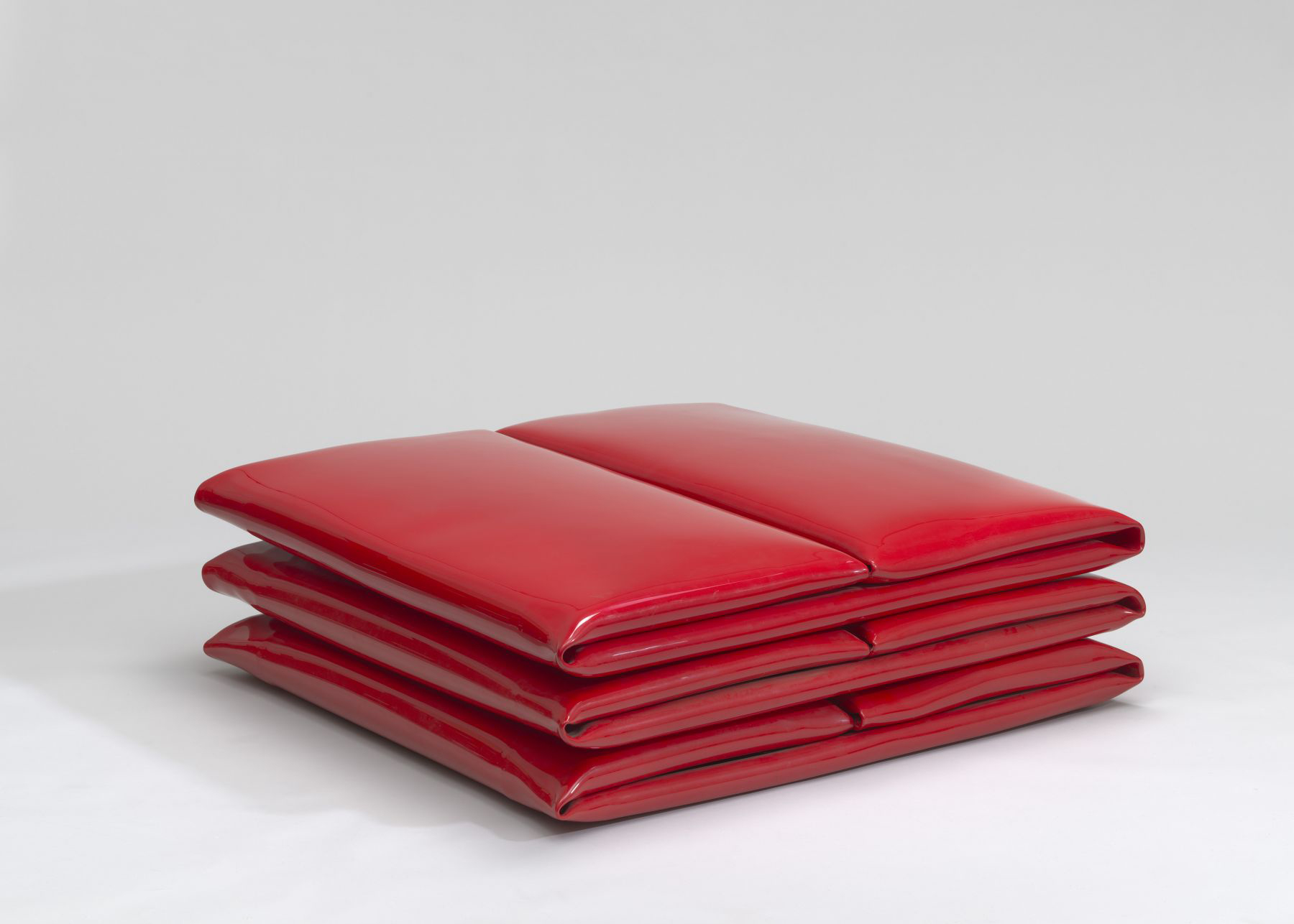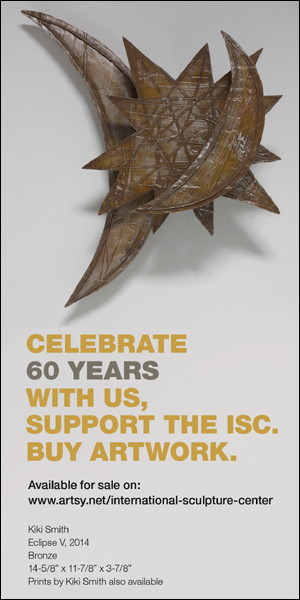Mimi Herbert and her fraternal twin were only 12 when their father, a portrait photographer, paid them a quarter a head to tint his sepia prints with oils. Their mother had studied at Pratt, and an uncle, a New York artist, marched them through museums with pictures that gave Herbert nightmares. Still, she focused on drawing, calling it “a gift, a bulwark against the anxiety of the times.” Even now, after decades of recognition as a sculptor, she relies on draftsmanship to plot permutations of the acrylic sheets that she morphs into gleaming, three-dimensional forms.
Herbert’s evolution as an artist owes much to chance. As a college theater major, she took a course in Indian religions that proved so fascinating she went to Penn for a masters in Asian studies. Inspired by Chola bronzes to create her own, she won two fellowships and a grant to study Hindi. Then, marriage to an international planner/architect opened a range of possibilities—from power tools at Berkeley to casting bronze and aluminum in a Calcutta foundry and glassblowing at Penland. Between sojourns in places like El Salvador, New Zealand, Brazil, and Haiti, Herbert earned an MFA in printmaking at American University. Now, at 86, based in Virginia, she is enjoying renewed visibility with recent acquisitions by the Phillips Collection and the National Gallery of Art.
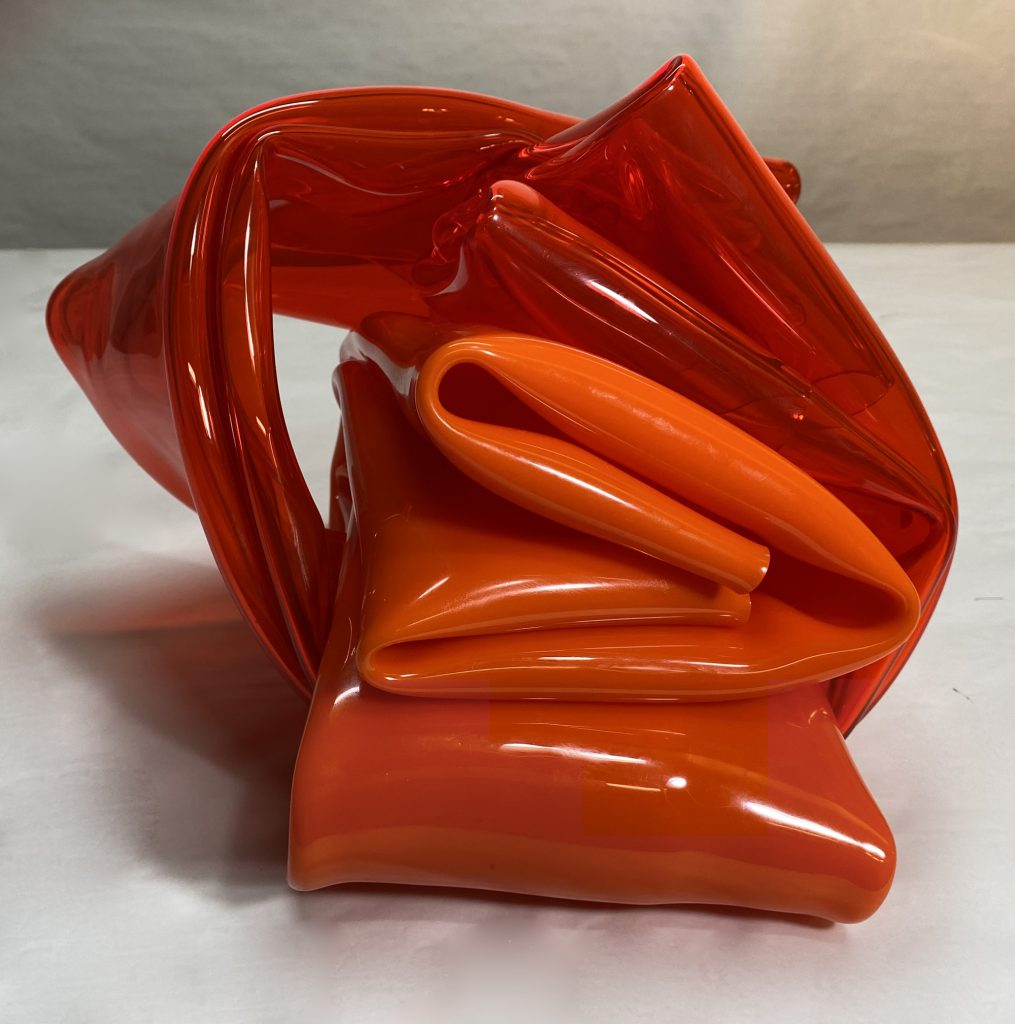
Jean Lawlor Cohen: How did living abroad impact your art-making?
Mimi Herbert: In 1964, a Ford Foundation project took us and our infant daughter to Calcutta for three years. During that time, I was befriended by Sabari Roy Choudhury, a student of Henry Moore. I made bronzes and showed my work at the Chemould Gallery, one of the oldest in India. Our daughter Rachel’s bed inspired an abstract bronze that won first prize at the Indian Academy of Fine Arts, and the Indian press credited “the American lady” with “strange and disjointed objects…mystery and magic power.”
JLC: Why the shift to plastic?
MH: I’d planned to continue with bronze, but when we returned to the U.S. in 1967, its cost was prohibitive. Casting in India was only 29 cents a kilo. So, I found Uvex, a new plastic so flexible I could bubble its surface with suction from vacuum cleaner hoses. My daughter Devorah likes to remind me that in a scene from The Graduate, which was made that same year, a man tells Dustin Hoffman/Ben Braddock, “There’s a great future in plastics. Think about it.” With fantastic forms made out of Uvex, I had a solo show at Henri Gallery, the first of several there over the next 12 years.
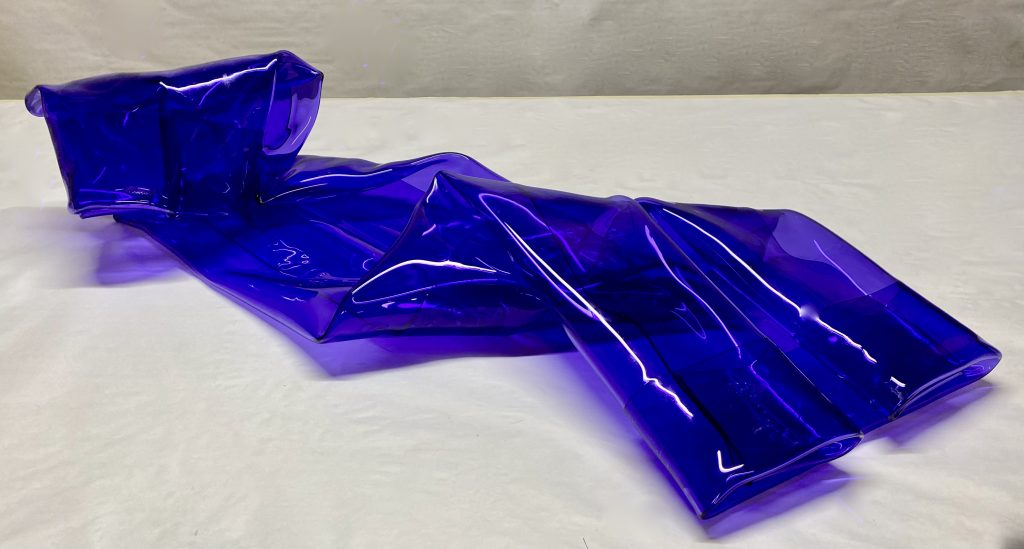
JLC: You soon went abroad again?
MH: In 1971, my husband’s work took us to Pakistan, where Uvex wasn’t available. I ordered acrylic sheets from Japan, and they arrived on the back of a camel. But that material didn’t work well with vacuum-forming, so I gave up on molds and suction and began to make folds. I could see how the heated acrylic responded to lifting and folding, so that’s the technique I’ve used ever since.
By 1976, we were in El Salvador, and forming plastic wasn’t an option. That sent me back to drawing and to life classes with Benjamin Saul, a prominent expat Spaniard known for his figurative sculpture. But by 1978, civil unrest and threats of violence forced us to leave, so we drove into Mexico with our daughters and the dog. When we crossed the U.S. border, I felt like kissing the ground.
In the following years, my husband worked abroad, but I stayed in Virginia and juggled making art, raising teenage daughters, and teaching at two local colleges. In 1990, we moved to Jakarta for five years, and a chance encounter led me into the world of Wayang Golek theater. I made drawings of the puppets, characters from the Hindu epic stories, and I wrote and helped illustrate the book Voices of the Puppet Masters. I think drawing enabled me to see what informs good sculpture. Maybe that’s why an artist friend said my sculptures make “a dream-like reference” to the human figure.
JLC: Where do your shapes come from?
MH: They form spontaneously in my head. That’s why I’d never take any drug that might block visions. Sometimes the idea for a sculpture comes out of a previous work, but more often it comes as I’m waking up or falling asleep.
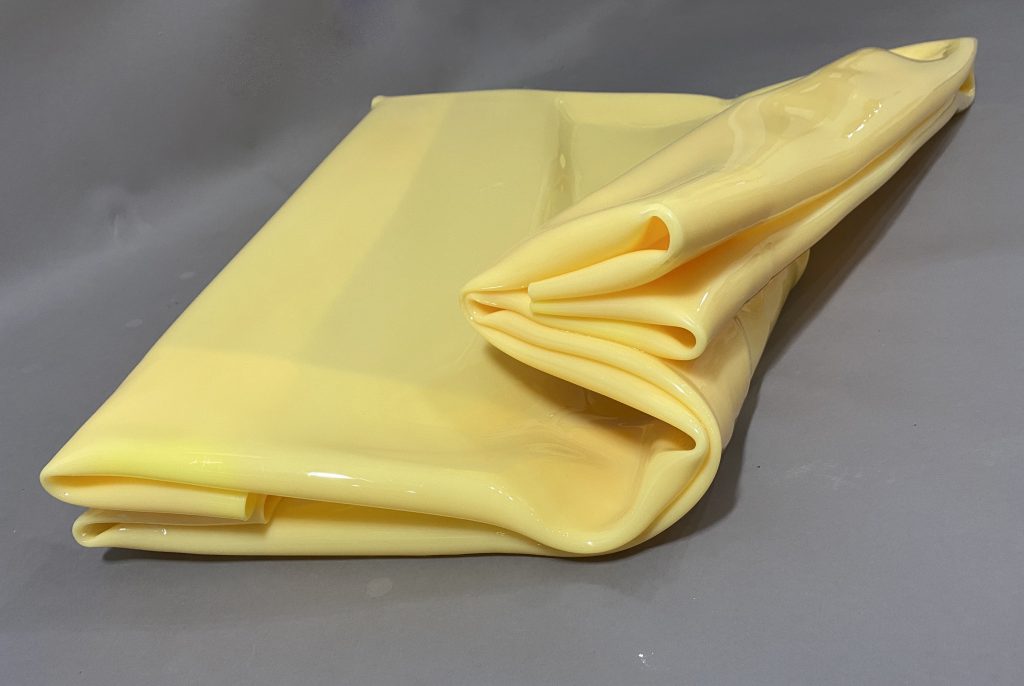
JLC: What do you say when writers compare your works to origami creatures and crumpled napkins?
MH: It goes right over me. I’m really good at ignoring bad press.
JLC: Are some of your titles meant to evoke nature?
MH: Yes, but Coral Reef and Tulip have no actual botanical reference. No oceans or flowers were in my mind. Recently, I finished a yellow wall piece for the Phillips Collection, a calm work with a single corner fold. After showing it to a visitor in my studio, we walked outside, and there on a bush by the front door was a very still yellow butterfly. It wouldn’t fly away, so we agreed the title had to be Butterfly.
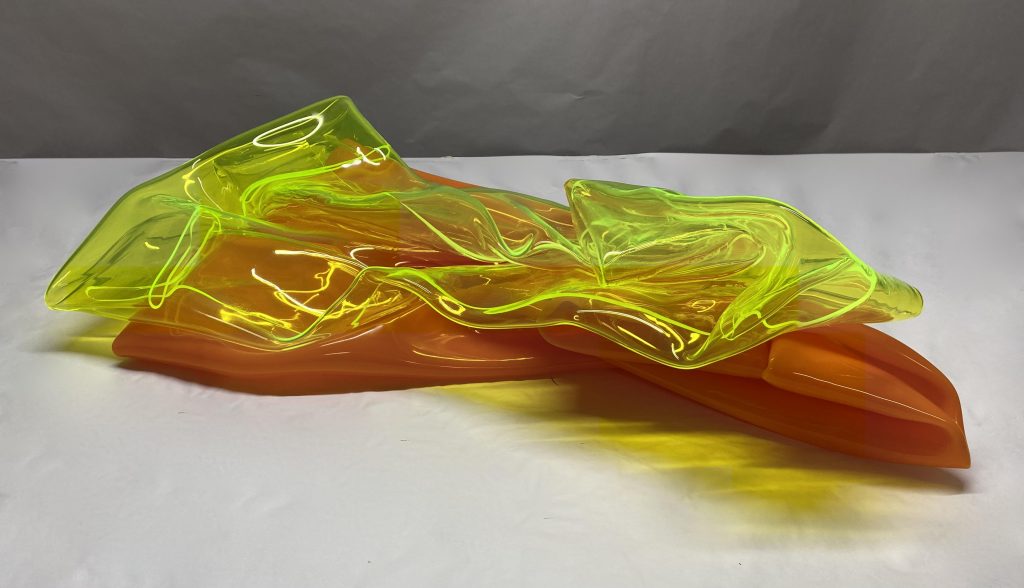
JLC: Do you always title your works after the fact?
MH: Yes, and I go with what they suggest, like Kimono, or I ask what others see. I have an interest in physics, so that factors into Quasar, Quark, and Singularity. I read myths in Sanskrit, so Hindu characters inspirit some of the work, like Durga Reclining. She’s a Hindu goddess who protects against demons, but there’s irony in her being transparent, since she’s called “the one who cannot be accessed easily.”
JLC: How do you source the acrylic?
MH: For months, I consider whether sheets should be clear or opaque and what colors I need. To cut costs, I order 12 sheets at a time from Gavrieli Plastics, which has a range of colors and opacities.
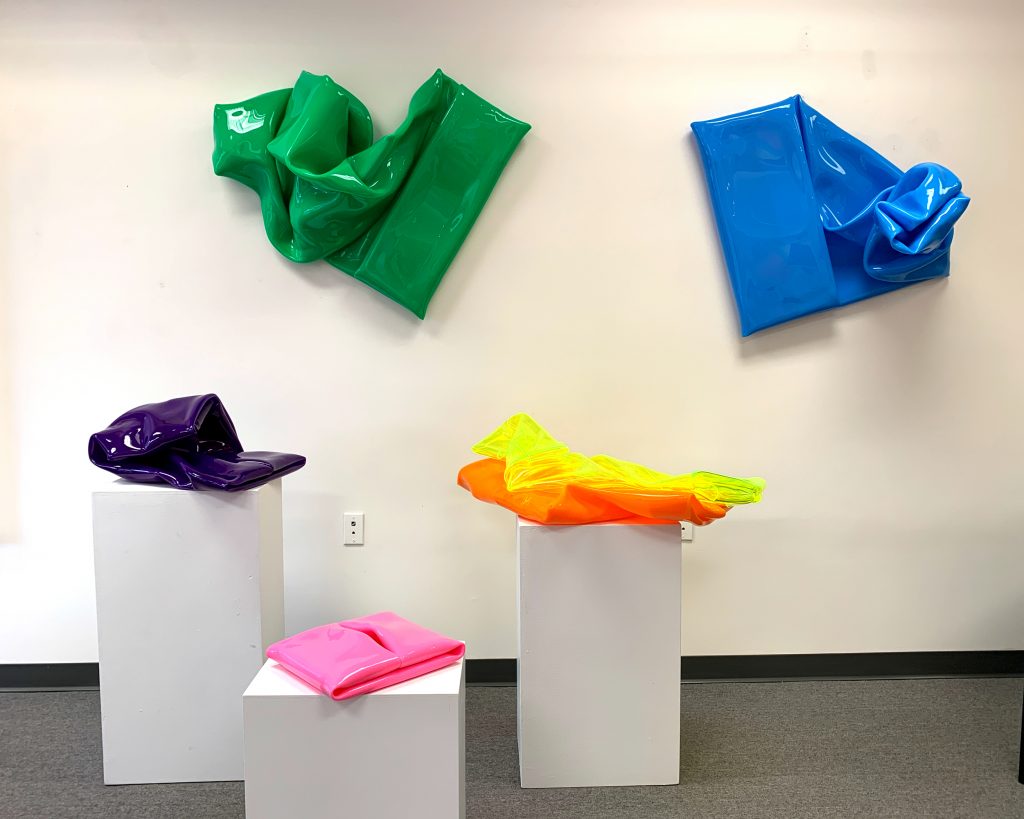
JLC: Could you explain how you plot a work?
MH: I structure every piece as a three-dimensional paper model. I cut a desired length of paper out of blank newsprint and inscribe the placement of the folds, usually eight or nine, and the order of folding the sections. Using the paper version, my helpers and I practice the sequence of rapid moves that will be required. We know that the folds become more and more complex as the piece progresses. Then, the acrylic sheet is laid out so I can mark the fold lines on it with heat-resistant tape.
JLC: What are the steps of the folding process?
MH: When it’s time to place a sheet on the light box, we put on safety goggles and protective gloves. Set in rows within the box are 60 lamps that heat to 280–300 degrees. We must position wood boards as “masks” to block the heat from parts not to be folded, and the configuration differs for each fold. Only one area—say 10 inches by 90 inches—is heated at a time.
I keep track of the timing of each step on a notepad, knowing that different colors heat at different speeds. Those notes help me predict and modify what can happen later on. With my glove, I gauge when a fold line is malleable and ready to be moved to the forming table. That’s where we lift a segment and make the fold, and I smooth the surface with a soft cloth. If the plastic becomes too hot, it bubbles or sticks to itself. If it cools too much in the forming, it cracks. So, all of this must happen quickly—within 30 or 40 seconds—before the acrylic hardens. I have to have my wits about me. Sometimes a fold doesn’t happen as I predicted, so I stay calm and allow the flow to create its own shape.
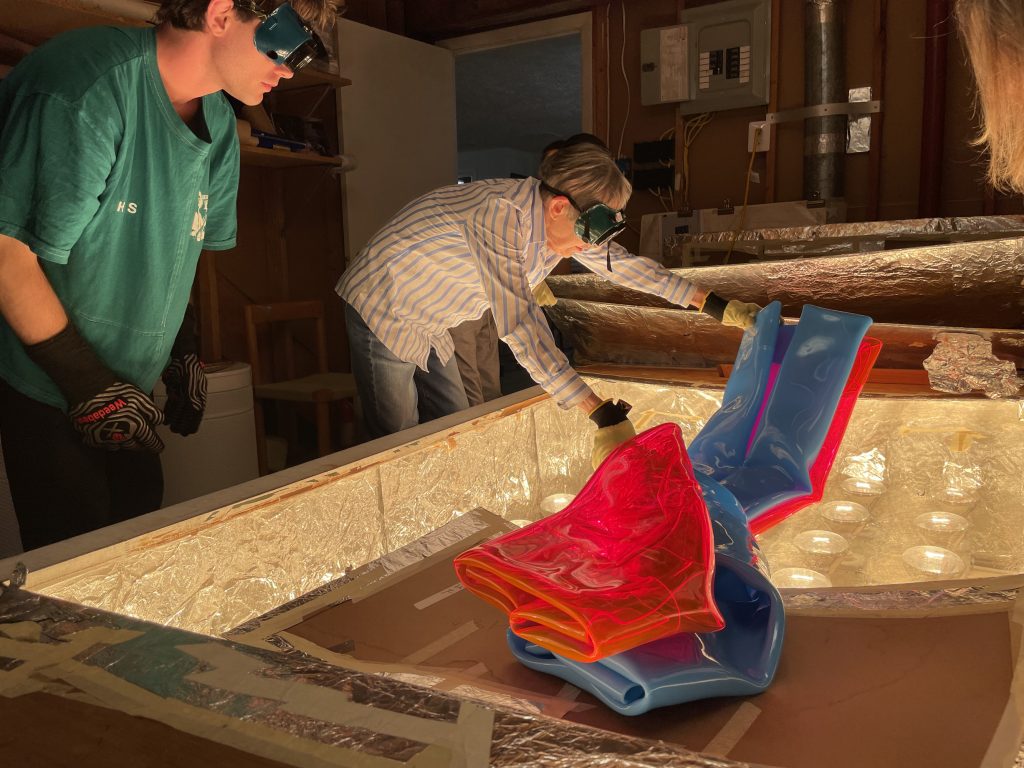
Photo: Courtesy the artist
JLC: How important is color?
MH: I think about combinations months ahead. Once I planned a piece using purple and yellow acrylic but then realized that, since those were color wheel opposites, it would be too predictable. I eventually used a greenish-yellow translucent neon sheet, and the yellow set my teeth on edge. I have to trust my intuition.
JLC: How did the National Gallery acquire Red Triplet (1974)?
MH: When the Corcoran Gallery of Art closed, curator Harry Cooper was told to choose pieces for the NGA permanent collection. He didn’t know my work until then, but he said this piece jumped out at him. He saw it as sleek and as hard as Minimalism but also as organic and “soft” as post-Minimalism. First he installed it in an East Building gallery alongside David Novros and Anne Truitt and then in a dramatic spot on the mezzanine.
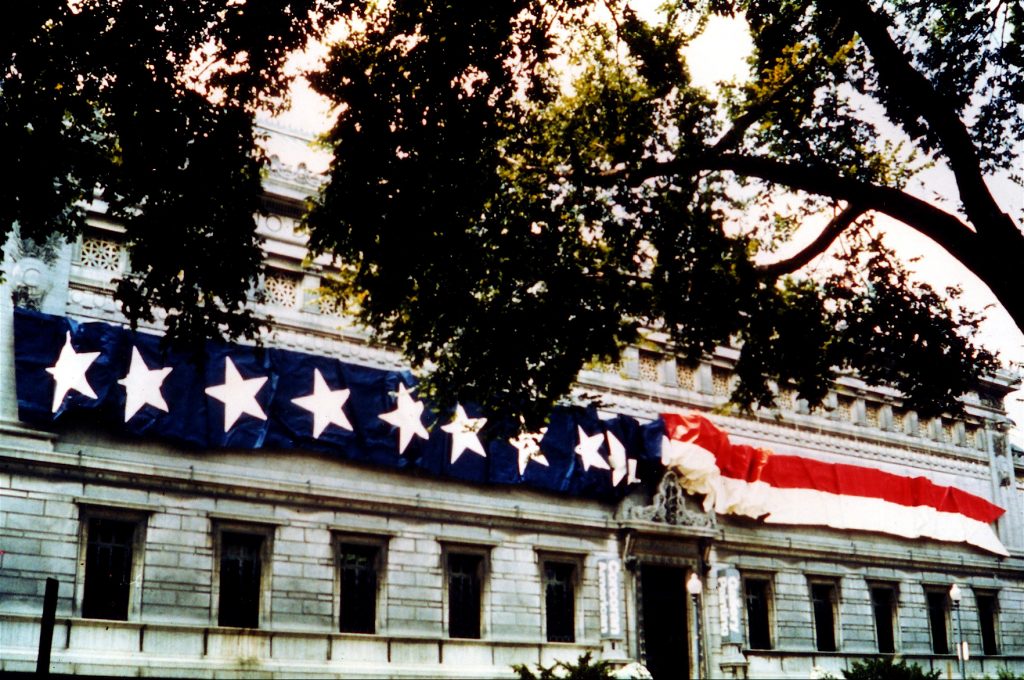
JLC: You’re committed to abstraction, with one exception—the American flag. Why the flag?
MH: It’s a powerful image, especially when folded at a military funeral, but its meaning changes with context and over time. When India bombed Pakistan, we escaped home, and I felt patriotic and grateful. Now two Smithsonian museums own works from the silkscreened series. My “Tribute” sculptures created in the aftermath of 9/11 hung in an American History Museum exhibition, and American University’s Katzen Center hung my response to border tension, a hybrid U.S. and Mexican flag.
JLC: Could you describe the 1976 flag project that brought high visibility to your work?
MH: For America’s bicentennial, the Corcoran Gallery of Art commissioned four pieces. Three flags framed a doorway at the top of the museum’s grand staircase. The fourth spanned the building’s 17th Street façade—a 165-foot-long banner that replicated an actual U.S. Navy commission pennant.
Roy Slade, then director of the Corcoran, approved my proposal drawings, and for six months I researched challenges like waterproofing. I chose Hypro paper because it was thick, archival, and mold resistant. It could be used dry or moistened and molded into shapes that stay put after they dry. And, most important, Grumbacher was giving it away.
For the façade piece, I made a small paper model that called for seven transportable sections. We knew we needed able-bodied volunteers and put out a call. We laid the 36-inch-wide Hydro strips outside on our dead-end street, which had almost no traffic, and then glued them together to create each section. Next, I rolled and stenciled the surfaces with Nazdar inks, a hardy outdoor signage paint I’d used to silkscreen earlier flags.
The various pieced works were then rolled up, and a neighbor’s truck hauled them to a plot of ground beside the Corcoran Gallery. There, we hosed them down, shaped them, and added a foam backing. Overnight, heat lamps managed to dry the sections that were, by then, roped and braced with supports like theater flats. We didn’t plan it, but the installation just happened to fall on Flag Day, June 14.
A crane did the lifting. Because we had no budget, I’d opened the yellow pages and put my finger randomly on suppliers. The first man I called not only agreed to provide a crane pro bono but also said he’d studied at the Corcoran School of Art. So, with a team of students, neighbors, and friends, the pieces were ready to be lifted and joined. Although my husband designed cables for securing to the façade, a problem arose. As we pondered what to do, some passersby stopped to ask if they could help. By chance, they were visitors from Canada who knew how to hang stage sets at the Stratford Theatre.
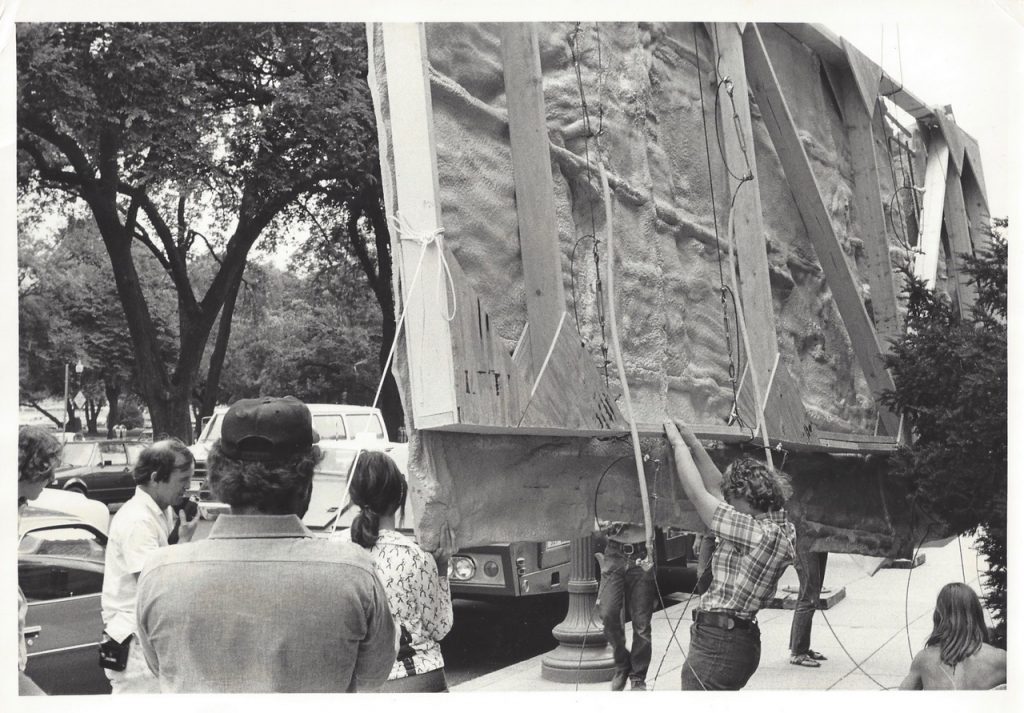
JLC: How has your recent work evolved?
MH: In the last few months, I’ve risked making pieces in which transparent and opaque elements coexist. To pull this off, I must form them over the hot lights at the same time. Layering creates surprising colors like an intense orange when clear yellow overlaps shocking pink. Of course, even a monochrome work like Ruach (2023) yields a range of purples by folding upon itself.
JLC: What are you experimenting with now?
MH: I’m looking closely at remnants of larger works. From a cache of cut-offs, I formed Purse (2023), a pouch of yellow and black acrylic swaths that hangs on pink and blue straps from a nail. I made Entanglement (2022), a more abstract hanging piece, out of narrow strips of remnant plastic. It was difficult to complete, because this cascade of ribbons had to be placed on the hot lights many times.
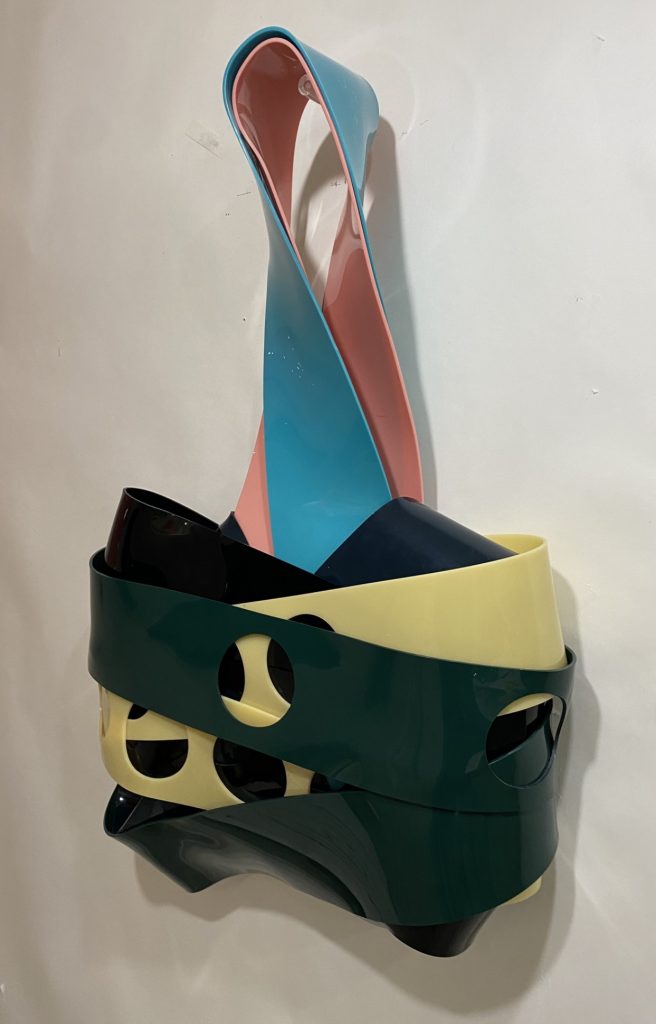
JLC: What might you do next?
MH: I’ve noticed how easily scratches appear on neon-like acrylic, and that suggests I could intentionally mark the surfaces. Maybe I should try a little calligraphy. The drawing impulse has never quite gone away.
Mimi Herbert’s solo exhibition at Amy Kaslow Gallery in Bethesda, Maryland, is on view June 6 through July 21, 2024.



